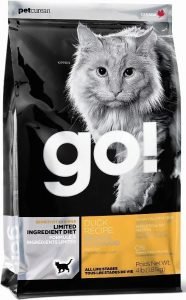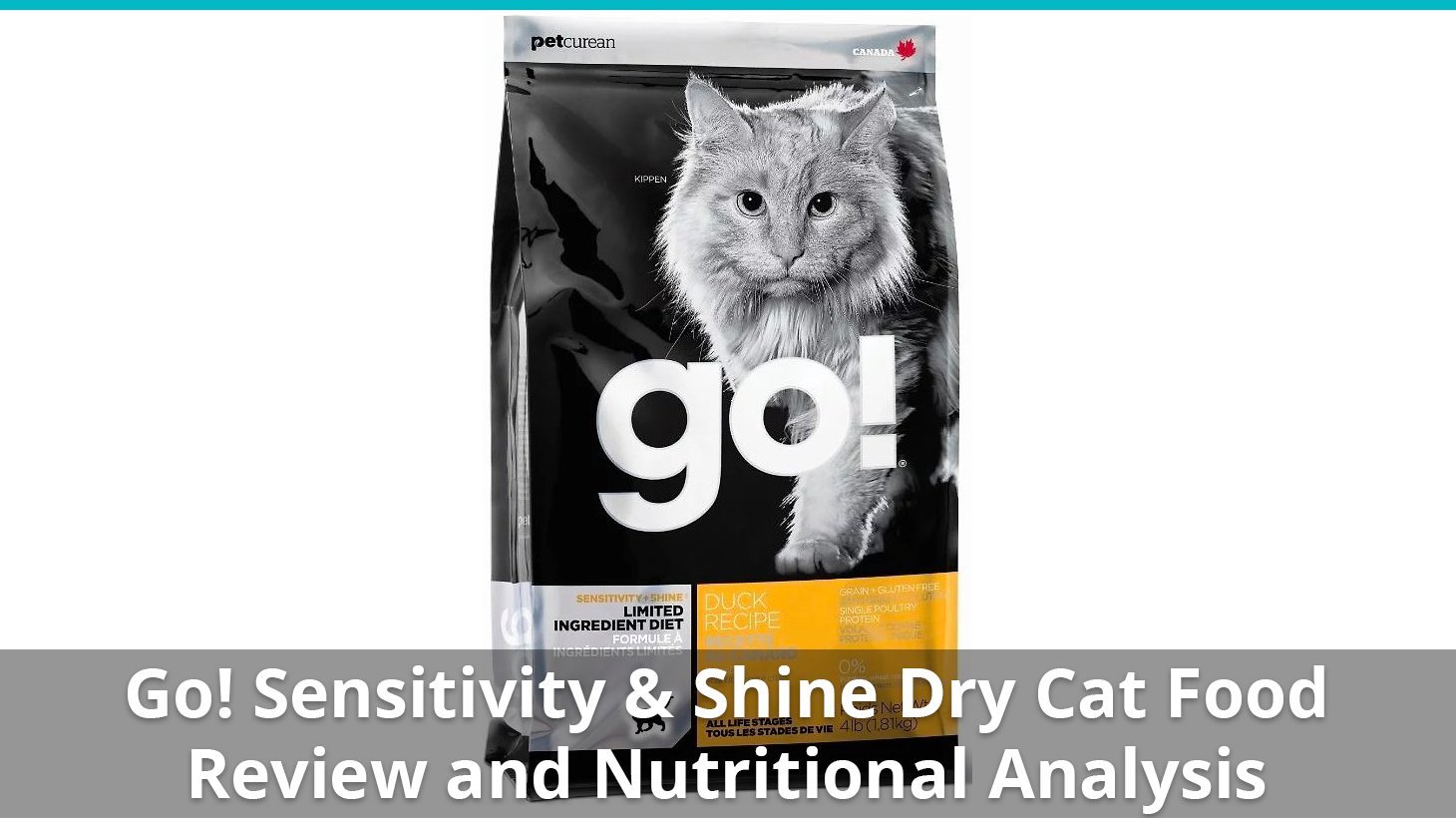Our review process is unbiased and based on extensive research. If you buy through the links on our site, we may earn a commission.
Rating
- Meat is the first ingredient – 1 Star
- Uses some unnamed meats – 1 Star
- Above average protein content – 0 Star
- Less than 4 controversial ingredients – 0.5 Star
- Catological Discretionary Rating – 0 Star
Here’s a few important points:
- Meat is the first ingredient
- Quite a lot of filler ingredients, both in number and volume
- Low protein, high carbohydrate
- Extra vitamins, high quality, proteinate versions of some minerals, and probiotics have been added
Go!’s Sensitivity + Shine product line includes 3 dry recipes/flavors.
Each recipe below includes its related AAFCO nutrient profile when available on the product’s official webpage or packaging: Growth (G), Maintenance (M), All Life Stages (A), Supplemental (S) or Unspecified (U).
The star rating is a rough average of all of the flavors in a single line of food. If an individual recipe scored lower or higher, we will mark that below, next to the flavor.
- Go! Sensitivity + Shine Duck (A) 2 stars
- Go! Sensitivity + Shine Trout & Salmon (A)
- Go! Sensitivity + Shine Pollock (A)

Go! Sensitivity + Shine Duck was selected to represent the other products in the line for this review.
Go! Sensitivity + Shine Duck
Dry Cat Food
| Estimated Nutrient Content |
| Protein | Fat | Carbs | |
|---|---|---|---|
| Guaranteed Analysis | 31% | 15% | NA |
| Dry Matter Basis | 34% | 17% | 37% |
| Calorie Weighted Basis | 31% | 36% | 33% |
Estimated Dry Matter Nutrient Content
Fiber (guaranteed analysis)
3.5%
Calories/100g
422
Is real, named meat the first ingredient?
Yes
Ingredients
De-Boned Duck, Duck Meal, Whole Dried Egg, Peas, Pea Flour, Tapioca, Lentils, Chickpeas, Chicken Fat (Preserved with Mixed Tocopherols), Flaxseed, Natural Flavour, Sodium Chloride, Choline Chloride, Calcium Carbonate, Dried Chicory Root, Phosphoric Acid, Potassium Chloride, Vitamins (Vitamin A Supplement, Vitamin D3 Supplement, Vitamin E Supplement, Niacin, Inositol, L-Ascorbyl-2-Polyphosphate (a Source of Vitamin C), Thiamine Mononitrate, D-Calcium Pantothenate, Riboflavin, Pyridoxine Hydrochloride, Beta-Carotene, Folic Acid, Biotin, Vitamin B12 Supplement), Minerals (Zinc Proteinate, Iron Proteinate, Copper Proteinate, Zinc Oxide, Manganese Proteinate, Copper Sulphate, Calcium Iodate, Ferrous Sulphate, Manganous Oxide, Sodium Selenite), Dried Lactobacillus Acidophilus Fermentation Product, Dried Enterococcus Faecium Fermentation Product, Taurine, Dried Rosemary.
Ingredients in red are controversial or of questionable quality.
Ingredient Breakdown
The first ingredient in this cat food is deboned duck. Good.
While quality of the individual ingredient can vary, duck is a good protein source for cats.
It’s also important to note that duck contains about 70% water, so when it is processed and cooked for use in cat food, it will become a smaller part of the total recipe.
The second ingredient is duck meal. Good.
Duck is a very good protein source for cats.
Duck meal is a concentrated form of duck, and is considered a high quality ingredient.
In short, much of the moisture of the duck is taken away, and you are left with a very high-protein, low-moisture powder-like substance.
The inclusion of duck meal helps to ensure a higher protein level.
The third ingredient is whole dried egg. Good.
Even though eggs are not meat, they are a highly digestible form of protein.
In fact, they are one of the most complete, bioavailable forms of protein for both humans and cats.
As long as it is not the main protein ingredient, the addition of egg is a quality ingredient
The fourth ingredient is peas. Bad.
Peas are a quality carbohydrate, but cats don’t need much in the way of carbohydrates.
They are full of fiber, but also contain a fair amount of protein, which we should keep in mind when judging the meat content of this food.
There probably aren’t many peas in here, but there really doesn’t need to be any.
The fifth ingredient is pea flour. Bad.
Pea flour is “the fraction remaining after removal of fiber from pulse seeds.”
Again, cat’s don’t need much in the way of carbs, and peas are often used as a filler in grain-free recipes.
The sixth ingredient is tapioca. OK, but with reservations.
Used in many grain-free recipes as a starch to bind the food together.
While it’s not very nutritional and doesn’t compare well to grains in some cases, there’s likely not enough of it to cause any digestive issues for your cat.
The seventh ingredient is lentils. Bad.
An obvious non-biologically appropriate carbohydrate filler, beans are at least potentially better than corn.
They are unlikely to do any damage to your cat.
However, some cats may have trouble digesting them.
They are also protein-rich, which means the actual meat content of this recipe may be lower than the macronutrient profile suggests.
They are usually used as a cheap protein source to cover up using only a little bit of meat in the recipe.
The eighth ingredient is chickpeas. Bad.
An obvious non-biologically appropriate carbohydrate filler, beans are at least potentially better than corn.
They are unlikely to do any damage to your cat.
However, some cats may have trouble digesting them.
They are also protein-rich, which means the actual meat content of this recipe may be lower than the macronutrient profile suggests.
This recipe includes a number of other ingredients, but once you get down this far, none of them will be in large enough quantities to make a real difference, except for the added vitamins and minerals.
However, there are still a few things you should know.
This recipe uses the proteinate form of minerals, which means that they should be easier to digest for your cat, and be more readily available for her body to use to maintain her health. This is usually a sign of a quality food.
There are also many probiotic strains which help introduce enzymes into the gut to break down the food better and make it more digestible and bioavailable. These are generally considered high quality ingredients.
To read a more in depth article about any of the ingredients listed here, check out our Cat Food Ingredient Wiki (currently under development).
The Catological Verdict on Go! Sensitivity + Shine Dry Cat Food
From top to bottom, this is an average dry product.
The recipe starts with meat, which is always a good sign.
Unfortunately, it’s let down by the high amount of carbohydrate fillers.
It has significantly below average protein, and significantly above average carb level. This is not a good mix when looking for the optimal diet for your feline friend.
This is not a great example of a dry food you should be feeding your cat.
A combination of meat being the first ingredient and there being quite a lot of fillers have us believing that it’s not just a meat-based recipe. Therefore we can safely assume that this is a mixed meat- and plant-based cat food, which is not quite ideal for your carnivorous feline’s dietary needs.
To review, on a dry matter basis, this food is 34% protein, 17% fat, and 37% carbs.
As a group, the brand has an average protein content of 39%, and average fat content of 18%, and an average carb content of 32%.
Compared to the other 2000+ foods in our database, this food has:
- Below average protein.
- Average fat.
- Above average carbs.
Because the first ingredient is meat, but there are way too many filler ingredients, our rating for this brand is 2.5 stars.
Not recommended.
Go!’s Cat Food Recall History
We do not believe that a recall indicates a low quality food or company, and we respect the fact that sometimes things happen that cause a manufacturer to recall a food.
Usually these things are non-life-threatening, and we think it’s important to take a moment to be thankful about just how few recalls there really are in the industry, considering the enormous volume of food produced.
However, we do believe that a history of recalls may point to a larger issue with a company, and that discerning consumers want to know who they’re buying from, especially when it comes to something as important as the food you feed your beloved cat.
Here is a list of recalls that have affected the Go! brand in the past:
- November 2003 – Reports of liver failure and disease – All products manufactured in Texas affected
If you want to stay up to date on the latest recall information affecting your cat’s food, sign up to our email list and receive an email every time a recall is announced. We’ll also let you know about any updated ratings, recipe changes, or new cat foods on the market. (Our alert system will be launched shortly, check back soon.)
Where To Buy Go! Dry Cat Food
We recommend purchasing your pet products from Chewy.com. They continually prove that they walk the walk while talking the talk, and I’ve never dealt with a more dedicated pet-parent base of people than those who work at Chewy.
Plus, they offer 20% off and free shipping on lots of orders.
Not Convinced?
Check out our ratings and reviews of the best cat foods in our comprehensive, data-backed guide right here.

